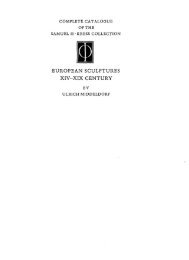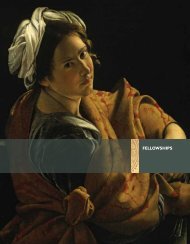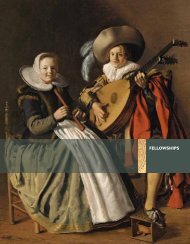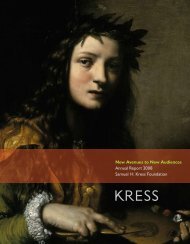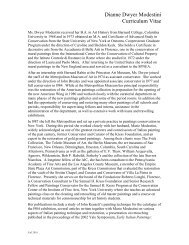The Campus Art Museum - Samuel H. Kress Foundation
The Campus Art Museum - Samuel H. Kress Foundation
The Campus Art Museum - Samuel H. Kress Foundation
You also want an ePaper? Increase the reach of your titles
YUMPU automatically turns print PDFs into web optimized ePapers that Google loves.
2008). 4 This emphasis reflects a larger cultural pattern of perceiving teamwork and<br />
interdisciplinary knowledge as vital in a globalized world. Although suspicious<br />
of the degree to which such academic rhetoric is actualized, particularly in<br />
the classroom where budget allocation structures continue to work against<br />
interdisciplinary and collaborative teaching, I heard a lot about these efforts. <strong>The</strong><br />
institutions that support collaborative and interdisciplinary learning tend to also<br />
support the involvement of the campus art museum in these activities.<br />
KU offers an example. Staff and faculty there have created <strong>The</strong> Commons, a<br />
partnership that includes the Hall Center for Humanities, the Biodiversity Institute,<br />
and the Spencer <strong>Museum</strong> of <strong>Art</strong>. Its purpose is to explore the relationships between<br />
nature and culture across the sciences, humanities, and arts. Each spring, a<br />
thematic Commons course, in collaboration with the University Honors Program, is<br />
proposed. Academic departments suggest speakers and <strong>The</strong> Commons then funds<br />
a set of cross-disciplinary talks. Students attend the speaker series and engage<br />
with faculty in small groups. <strong>The</strong> Commons also supports research that integrates<br />
methods and ideas from the sciences, humanities, and the arts. According to a KU<br />
administrator, “<strong>The</strong> museum’s connection to <strong>The</strong> Commons has been fantastic…<br />
that relationship with <strong>The</strong> Commons is all about getting out of our silos and<br />
collaboration, and collaboration in a way that really yields new research and new<br />
ways of thinking.”<br />
Faculty and museum staff at other institutions similarly talked about annual<br />
cross-disciplinary, and often first-year, seminars where a theme (such as peace)<br />
is chosen and faculty across the disciplines shape courses around that theme. In<br />
conjunction with these thematic seminars, the campus art museum develops an<br />
exhibitions and curators or museum educators lead academic interactions with the<br />
exhibition, while also serving as guest lecturers in classes.<br />
Some of the museums play collaborative roles on campus and in the<br />
community as well. For example, as Oberlin College went through a renovation<br />
process, it was responsive to a campus “green” initiative, investing in geothermal<br />
wells to reduce its energy consumption by fifty percent. This was recognized by<br />
students as “setting a standard and showing what the museum can do for the<br />
environment.” For another example, over the last five years, the University of<br />
Missouri (MU) <strong>Museum</strong> of <strong>Art</strong> and Archaeology has run a special therapeutic art<br />
program for Alzheimer’s patients in collaboration with the Adult Day Connection,<br />
and in consultation with the MU Interdisciplinary Center on Aging and the<br />
Osher Lifelong Learning Institute. <strong>The</strong> program includes art creation, visits to the<br />
museum, and provision of reproductions of favorite works for people’s rooms. <strong>The</strong><br />
exemplary campus art museum links with and bring its strengths to communities<br />
and initiatives beyond its walls.<br />
Institutional Structures<br />
<strong>The</strong> culture of the museum is a mix of the physical space, the collections, and<br />
the people—museum staff, faculty, administrators. With people it’s a history<br />
4. <strong>The</strong> educational practices identified for high-impact learning include first-year seminars, common intellectual<br />
experiences, learning communities, writing-intensive courses, collaborative assignments and projects, research, diversity/<br />
global learning, service learning, internships, and capstone courses and projects.<br />
Supportive <strong>Campus</strong> Cultures and Structures<br />
11



